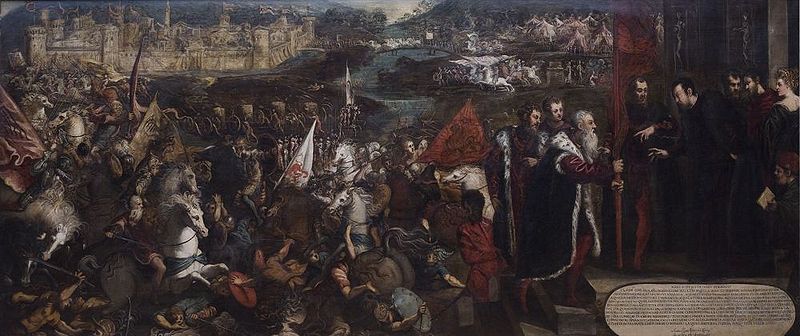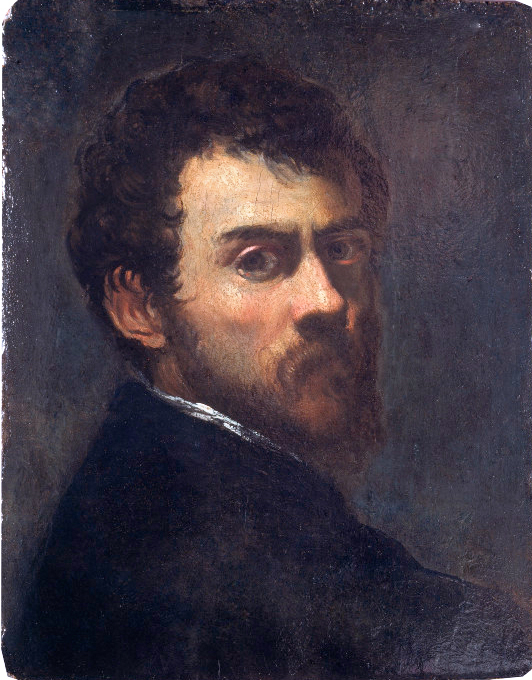|
Jacopo Tintoretto
Jacopo Robusti (late September or early October 1518Bernari and de Vecchi 1970, p. 83.31 May 1594), best known as Tintoretto ( ; , ), was an Italian Renaissance painter of the Venetian school. His contemporaries both admired and criticized the speed with which he painted, and the unprecedented boldness of his brushwork. For his phenomenal energy in painting he was termed . His work is characterised by his muscular figures, dramatic gestures and bold use of perspective, in the Mannerist style. Life The years of apprenticeship Tintoretto was born in Venice in 1518. His father, Battista, was a dyer – in Italian and in Venetian; hence the son got the nickname of Tintoretto, "little dyer", or "dyer's boy". Tintoretto is known to have had at least one sibling, a brother named Domenico, although an unreliable 17th-century account says his siblings numbered 22. The family was believed to have originated from Brescia, in Lombardy, then part of the Republic of Venice. Older studies ... [...More Info...] [...Related Items...] OR: [Wikipedia] [Google] [Baidu] |
Tintoretto - Self-Portrait As A Young Man
Jacopo Robusti (late September or early October 1518Bernari and de Vecchi 1970, p. 83.31 May 1594), best known as Tintoretto ( ; , ), was an Italian Renaissance painter of the Venetian painting, Venetian school. His contemporaries both admired and criticized the speed with which he painted, and the unprecedented boldness of his brushwork. For his phenomenal energy in painting he was termed . His work is characterised by his muscular figures, dramatic gestures and bold use of perspective, in the Mannerist style. Life The years of apprenticeship Tintoretto was born in Venice in 1518. His father, Battista, was a dyer – in Italian and in Venetian language, Venetian; hence the son got the nickname of Tintoretto, "little dyer", or "dyer's boy". Tintoretto is known to have had at least one sibling, a brother named Domenico, although an unreliable 17th-century account says his siblings numbered 22. The family was believed to have originated from Brescia, in Lombardy, then part of t ... [...More Info...] [...Related Items...] OR: [Wikipedia] [Google] [Baidu] |
Gallerie Dell'Accademia
The Gallerie dell'Accademia is a museum gallery of pre-19th-century art in Venice, northern Italy. It is housed in the Scuola della Carità on the south bank of the Grand Canal, within the sestiere of Dorsoduro. It was originally the gallery of the Accademia di Belle Arti di Venezia, the art academy of Venice, from which it became independent in 1879, and for which the Ponte dell'Accademia and the Accademia boat landing station for the '' vaporetto'' water bus are named. The two institutions remained in the same building until 2004, when the art school moved to the Ospedale degli Incurabili. History Early history The Accademia di Belle Arti di Venezia was founded on 24 September 1750; the statute dates from 1756.Accademia di belle arti di Venezia, 1750–2010. Cenni storici (in Italian) ... [...More Info...] [...Related Items...] OR: [Wikipedia] [Google] [Baidu] |
Self Portrait (Tintoretto)
''Self Portrait'' is a self-portrait by Tintoretto, dating to around 1588. It was in the Orleans Collection before it was bought for Marie Antoinette with the Château de Saint-Cloud in 1785. It is now in the Louvre, in Paris. References External linksLouvre: ''Self Portrait'' by Tintoretto Self-portraiture Paintings by Tintoretto Portraits of men Self-portraits 1588 paintings 16th-century portraits Mannerist paintings Portraits by Italian artists Tintoretto Jacopo Robusti (late September or early October 1518Bernari and de Vecchi 1970, p. 83.31 May 1594), best known as Tintoretto ( ; , ), was an Italian Renaissance painter of the Venetian school. His contemporaries both admired and criticized th ... Paintings in the Louvre by Italian artists Portrait paintings in the Louvre {{1580s-painting-stub ... [...More Info...] [...Related Items...] OR: [Wikipedia] [Google] [Baidu] |
Dawn (Michelangelo)
The Sagrestia Nuova, also known as the New Sacristy and the Medici Chapel, is a mausoleum that stands as a testament to the grandeur and artistic vision of the Medici family. Constructed in 1520, the mausoleum was designed by the Italian artist and architect Michelangelo. Situated adjacent to the Basilica di San Lorenzo in Florence, Italy, the Sagrestia Nuova forms an integral part of the museum complex known as the Medici Chapels. History Background The death of two scions of the Medici family, Giuliano de' Medici, Duke of Nemours (in 1516), and Lorenzo de' Medici, Duke of Urbino (in 1519), had deeply embittered Pope Leo X, the brother of Giuliano and uncle of Lorenzo, who wanted to ensure that they obtained a princely burial. It was also suggested by their cousin Cardinal Giulio de' Medici (later Pope Clement VII), commissioning Michelangelo's project for the façade for Basilica di San Lorenzo, engaging the artist in a new project for the basilica. The church had been th ... [...More Info...] [...Related Items...] OR: [Wikipedia] [Google] [Baidu] |
Book Of Genesis
The Book of Genesis (from Greek language, Greek ; ; ) is the first book of the Hebrew Bible and the Christian Old Testament. Its Hebrew name is the same as its incipit, first word, (In the beginning (phrase), 'In the beginning'). Genesis purports to be an account of the Genesis creation narrative, creation of the world, the early history of humanity, and the Jews#Origins, origins of the Jewish people. In Judaism, the theological importance of Genesis centers on the covenants linking God in Judaism, God to his chosen people and the people to the Promised Land. Genesis is part of the Torah or Pentateuch, the first five books of the Bible. Tradition credits Moses as the Torah's author. However, there is scholarly consensus that the Book of Genesis was composed several centuries later, after the Babylonian captivity, Babylonian Babylonian captivity, captivity, possibly in the fifth century BC. Based on the scientific interpretation of Archaeology, archaeological, Genetics, genetic, ... [...More Info...] [...Related Items...] OR: [Wikipedia] [Google] [Baidu] |
Samaria
Samaria (), the Hellenized form of the Hebrew name Shomron (), is used as a historical and Hebrew Bible, biblical name for the central region of the Land of Israel. It is bordered by Judea to the south and Galilee to the north. The region is known to the Palestinians in Arabic under two names, Samirah (, ''as-Sāmira''), and Mount Nablus (جَبَل نَابُلُس, ''Jabal Nābulus''). The first-century historian Josephus set the Mediterranean Sea as its limit to the west, and the Jordan Rift Valley, Jordan River as its limit to the east. Its territory largely corresponds to the Hebrew Bible, biblical allotments of the tribe of Ephraim and the western half of Tribe of Manasseh, Manasseh. It includes most of the region of the ancient Kingdom of Israel (Samaria), Kingdom of Israel, which was north of the Kingdom of Judah. The border between Samaria and Judea is set at the latitude of Ramallah. The name "Samaria" is derived from the Samaria (ancient city), ancient city of Sam ... [...More Info...] [...Related Items...] OR: [Wikipedia] [Google] [Baidu] |
Carmini
Santa Maria dei Carmini, also called Santa Maria del Carmelo and commonly known simply as the Carmini, is a large Roman Catholic church in the sestiere, or neighbourhood, of Dorsoduro in Venice, northern Italy. It nestles against the former ''Scuola Grande di Santa Maria del Carmelo'', also known as the '' Scuola dei Carmini''. This charitable confraternity was officially founded in 1597, and arose from a lay women's charitable association, the ''Pinzocchere dei Carmini''. The members of this lay group were associated as tertiaries to the neighbouring Carmelite monastery. They were responsible for stitching the scapulars for the Carmelites. History The church originally was called Santa Maria Assunta, and first dated to the 14th century (circa 1348). page338. The brick and marble facade contains sculpted lunettes by ... [...More Info...] [...Related Items...] OR: [Wikipedia] [Google] [Baidu] |
Andrea Schiavone
Andrea Meldolla (), also known as Andrea Schiavone or Andrea lo Schiavone, literally "Andrew the Slav", (c. 1510/15–1563) was an Italian Renaissance painter and etcher, born in Dalmatia, in the Republic of Venice (present-day Croatia) to parents from Emilia-Romagna, active mainly in the city of Venice. His style combined Mannerist elements, a relative rarity in Venice, with much influence from the mainstream of Venetian painting, especially Titian. Biography Meldolla was born in the Venetian-ruled city of Zara in Dalmatia, now Zadar in Croatia, the son of a garrison commander of a post nearby. Both of his parents came from the small town of Meldola, close to the city of Forlì in Romagna. His father, Simon, had been employed as a constable in the Dalmatian city, and therefore moved there with his family from Romagna. The Meldolla family continued to own property in Romagna until the early 16th century. He trained either in Zara or in Venice. Gian Paolo Lomazzo stated, i ... [...More Info...] [...Related Items...] OR: [Wikipedia] [Google] [Baidu] |
Blue Paper
Blue paper (known in Italian as ''carta azzurra'', ''carta cerulea'', and ''carta turchina'') has often been used as a support for drawings and prints by artists. With its inherent middle tone, blue paper is a particularly effective material for rendering the effects of three-dimensionality on a two dimensional surface. This effect is created through the use of light and dark drawing materials, like chalk, charcoal, ink, and white heightening, on blue paper. History Paper production can be traced back to China around 100 CE, arriving in Spain and then Italy via the Middle East around 1100. European cotton paper differs from Asian paper in that the Pulp (paper), pulp is composed mainly of processed rags rather than of plant fibers. The earliest extant mention of blue paper dates from a 1389 Bolognese statute that refers to paper size, quality, weight, and price. Its earliest use for drawing also originates in Italy, referenced below. Production The rags were processed into paper ... [...More Info...] [...Related Items...] OR: [Wikipedia] [Google] [Baidu] |



